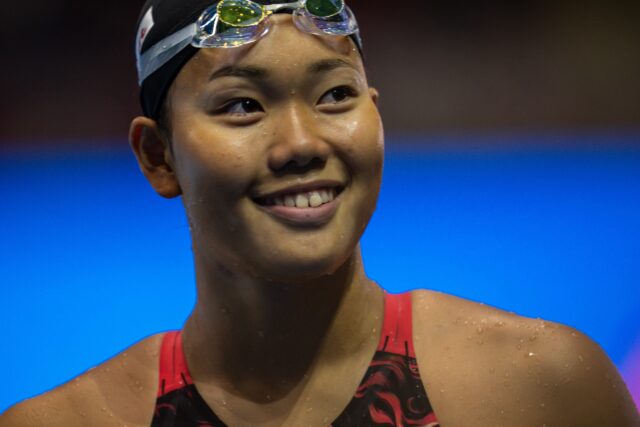By Madeline Folsom on SwimSwam

With fall around the corner, we are in the middle of NCAA preview season. We will continue our ranking of the 2025 women’s recruiting classes with #9-12. We have already released the honorable mentions and the #13-16 rankings
See Also:
A few important notes on our rankings:
- The rankings listed are based on our Class of 2025 Re-Rank. “HM” refers to our honorable mentions and “BOTR” refers to our Best of the Rest section for top-tier recruits.
- Like most of our rankings, these placements are subjective. We base our team ranks on a number of factors: prospects’ incoming times are by far the main factor, but we also consider potential upside in the class, class size, relay impact, and team needs. Greater weight is placed on known success in short course yards, so foreign swimmers are slightly devalued based on the difficulty in converting long course times to short course production.
- Transfers are included, though they are weighed less than recruits who arrive with four seasons of eligibility.
- For the full list of all verbally committed athletes, click here. A big thank you to SwimSwam’s own Anne Lepesant for compiling that index – without it, rankings like these would be far less comprehensive.
- Some teams had not released a finalized 2025-26 team roster at the time these articles were published, meaning it’s possible we missed some names. Let us know in the comments below.
Honorable Mentions
- UCLA, Wisconsin, South Carolina
Previously Ranked
- #16 Notre Dame
- #15 Duke
- #14 Ohio State
- #13 Louisville
#12 Michigan Wolverines
As a reminder, we don’t give as much weight to transfers in these rankings because they do not have four years of eligibility, which affects their strength as a “recruit”. Bella Sims is the top swimmer coming into the Wolverines this year, having won the NCAA title in the 200 and 500 free in 2024 and winning silvers in both backstroke events in 2025. She will be a very strong addition to the Michigan team, but she only has two years of eligibility remaining.
Sims has struggled the last two years, particularly in the distance freestyle events, but her backstroke events were very strong last year. In 2025, she finished 17th in the 500 freestyle, failing to make the final entirely as the reigning champion, and she earned runner-up finished in both backstroke events. On top of her individual points, she will be a strong relay addition to the Wolverines as the fastest backstroker and 100 freestyler and one of the fastest 200 freestylers on the team.
Of the incoming freshmen, there are two BOTR recruits moving to Ann Arbor later this month. Lila Higgo is a freestyler and backstroker who trains in Florida and will be coming in with sprint freestyle times of 22.64 and 49.25. She also has a 100 backstroke time of 52.72, which would be in scoring position at the Big Ten Championships, and sits about a second over the cutline of 51.68.
The other BOTR recruit is Montserrat Spielmann, whose times of 52.70 and 1:57.00 will add depth to the Michigan fly program that is led by rising senior Brady Kendall and rising junior Hannah Bellard.
#11 USC Trojans
The University of Southern California (USC) lost its top female swimmer at the end of last year. Kaitlyn Dobler won the 100 breaststroke conference title all five years she was in college, and she won the NCAA title in 2022.
The Trojans prepared for the loss exceptionally well with their recruiting class this year, bringing in the #15-ranked recruit, breaststroker Bella Brito. Brito had huge drops in the events this year, swimming 59.09 in the 100 breast and 2:08.72 in the 200 breast, which are both comfortably under the NCAA cutline and close to ‘B’ final position. She also has strong sprint freestyle times of 22.39 and 48.55, which will likely earn her spots on the freestyle relays as well as the medleys.
Brito will be joined by Kaitlyn Nguyen, who is bringing in lifetime bests of 1:00.80 and 2:10.28, which are both near the NCAA cutline. They will come in as the two fastest breaststrokers on the USC team, helping make up for the loss of Dobler.
They also picked up a few international recruits in Hungarian Olympian Dora Molnar and Belgian distance swimmer Alisee Pisane. Molnar, a backstroker, recently swam in the final of the 200 backstroke at the 2025 World Championships, where she finished 7th. Her prelims swim of 2:08.53 converts to 1:50.75, which would have been in the ‘A’ final at last year’s NCAAs. She also has very strong freestyle times that would be NCAA qualifications in their own right.
Pisane is a distance freestyle specialist, which sort of hurts her at the Division I level. She holds the Belgian National records in the 800 and 1500 freestyles, but only the 1500 is a conference and NCAA event. Her national record time of 16:22.18 converts to 15:53.26, which is well under the cutline in the event and would have been just outside the top 8.
As we have mentioned a few times, and will mention a few more as we continue moving through this list, it is incredibly difficult to predict how international swimmers will perform in the NCAA, which is why their commitments are not rated as high on these lists.
Finally, USC picked up graduate transfer Nicole Maier from Miami. Maier swam the 100 free, 500 free, and 400 IM at the 2024 NCAA Championships, where her highest finish was 11th in the 400 IM. Maier was originally intending to swim her 5th year for the Florida Gators, but she did not end up competing last year, and will instead spend her last year with the Trojans.
#10 Princeton Tigers
Princeton is not one of the teams that is typically in contention for a top finish at the NCAA Championships, finishing 39th at last season’s NCAA Championship with six points. They were the best team in the Ivy League last year, though, winning the meet by almost 200 points over Harvard, and their recruiting class this year only makes them stronger.
Their recruiting class is solely American recruits, which means we have a good idea of how they will perform, and it looks good for them. With the #16-ranked recruit and four BOTR recruits, they had one of the highest numbers of top recruits in the class.
Chloe Kim is their only top 20 recruit, coming in at #16 with her IM and distance freestyle events coming in under the NCAA cutline, and putting her in scoring position as a freshman. Kim saw massive improvements this year, dropping to 4:07.11 in the 400 IM, which would have been 16th in the “B” final. Her time also would have been 2nd at the Ivy League Championships behind Princeton’s Eleanor Sun. Sun was their highest scorer at the 2025 NCAAs, bringing in five points from her 12th-place finish in the 400 IM.
She was also under the cutline in the 500 free and 1650 free and she is within 2% of the cutline in the 200 backstroke and 200 butterfly, making her an incredibly versatile swimmer that could score in a wide variety of events at the conference championship this year, and potentially at the NCAA Championships in the future.
Sophia Sunwoo was our fastest BOTR recruit in the sprint freestyle events, dropping to 22.19 in the 50 and 49.16 in the 100. Both events would have been 2nd on the team last year behind rising senior Sabrina Johnston, and her 50 free would have won the Ivy League Championships. She will be a major addition in the relay events, and she is not far from a potential NCAA qualification.
Delaney Herr is another 22-second 50 freestyler and 49-second 100 swimmer who can make serious relay impacts, potentially helping Princeton’s relays score points this year, which would significantly improve their NCAA placement. Herr’s impact goes further than just freestyle relays, however. Her best times of 24.12 in the 50 back and 52.41 in the 100 back would have been first on the team last year, and could put her in the backstroke position on both medley relays.
Sophie Segerson is another backstroker who also swims the IM events. Her 200 backstroke would have been 2nd on the team last year to graduate Isabella Korbly at 1:55.47 and her 200 IM would have been 3rd, just behind Sun and rising junior Dakota Tucker. She also brings depth to the 200 freestyle, and potentially the 800 freestyle relay, with her 1:49.66 200 free time.
Their final BOTR recruit is Savannah Skow, a butterfly and IMer. She will slide in just behind senior Heidi Smithwick in the 100 fly at 52.90. Her biggest contribution, though, will come in the 200 freestyle, where her 1:45.80 is just a second over the NCAA cutline and would have been the fastest on the Princeton team and the fastest in the Ivy League conference. This will be a huge boost in the relays and in their point standings.
#9 Tennessee Volunteers
- SwimSwam Ranked Recruits: HM Amelia Mason (CO – free/fly), BOTR Nicole Zettel (NC – IM)
- The “Rest”: Mizuki Hirai (Japan – fly/back/free), Julianna Bocska (Germany – free), Alyssa Claborn (NC – back/fly), Milly Leonard (OH – breast/free), Avery Luedke (IL – free/back), Emma Rhines (TX – diving), Lilly Robertson (TN – free/back), Mere Whelehan (NC – free/back), Lilly Daley (Canada – free), Desharne Bent-Ashmeil (Great Britain – diving)
The Tennessee recruiting class for 2025 is huge with 17 new athletes coming in for the 2025-2026 swim season, and there are some heavy hitters.
Starting with the American-ranked recruits, we have honorable mention Amelia Mason. A sprint freestyler out of Colorado, Mason had a very strong senior year, dropping significant time in all three of the shorter freestyle events to be 22.64 in the 50, 48.89 in the 100 and 1:45.97 in the 200. Tennessee is not hurting for sprint freestylers, at least in the 50 and 100 events, as their top sprinter from last year, Camille Spink, still has two years of eligibility remaining. Mason will likely make an impact in the 200 freestyle, however, with only two returning swimmers having faster times from last season.
The Volunteers also picked up BOTR IMer Nicole Zettel, whose times of 1:58.08 and 4:11.10 would have been 2nd and 3rd among returning swimmers from last year and are just over the NCAA cutlines.
They also have a few huge international recruits coming in, namely World Junior Record holder Mizuki Hirai from Japan. Hirai holds the WJR in the women’s 100 butterfly at 56.33 from June of last year. This converts to 50.16, which would have been 5th at last year’s NCAA Championships with two graduates ahead of her. Hirai also has strong times in the 100 back and the sprint freestyle events, but her biggest contribution will come in the 100 fly. Hirai has also deferred her enrollment to the Spring, which doesn’t give her a ton of time to get used to yards swimming before conference meets and the NCAA Championships.
There will be two divers joining the program as well in Emma Rhines and Desharne Bent-Ashmeil. Rhines was our #5 diving recruit, having qualified for the three-meter finals at Junior Nationals in 2024. Bent-Ashmeil will be a significant addition to the program with three European Championship gold medals under her belt from 2024. The Tennessee divers only scored 25 points at last year’s SECs, so they have a lot of room for improvement in this area.
Ultimately, despite having a lot of recruits, their top two American recruits don’t fill huge areas of weakness within the team and their top international recruit will not have a lot of time to make the transition before she will be needed to perform, which is what earned them the 9th spot on this list.
Read the full story on SwimSwam: Ranking the 2025 Women’s NCAA Recruiting Classes: #9-12















